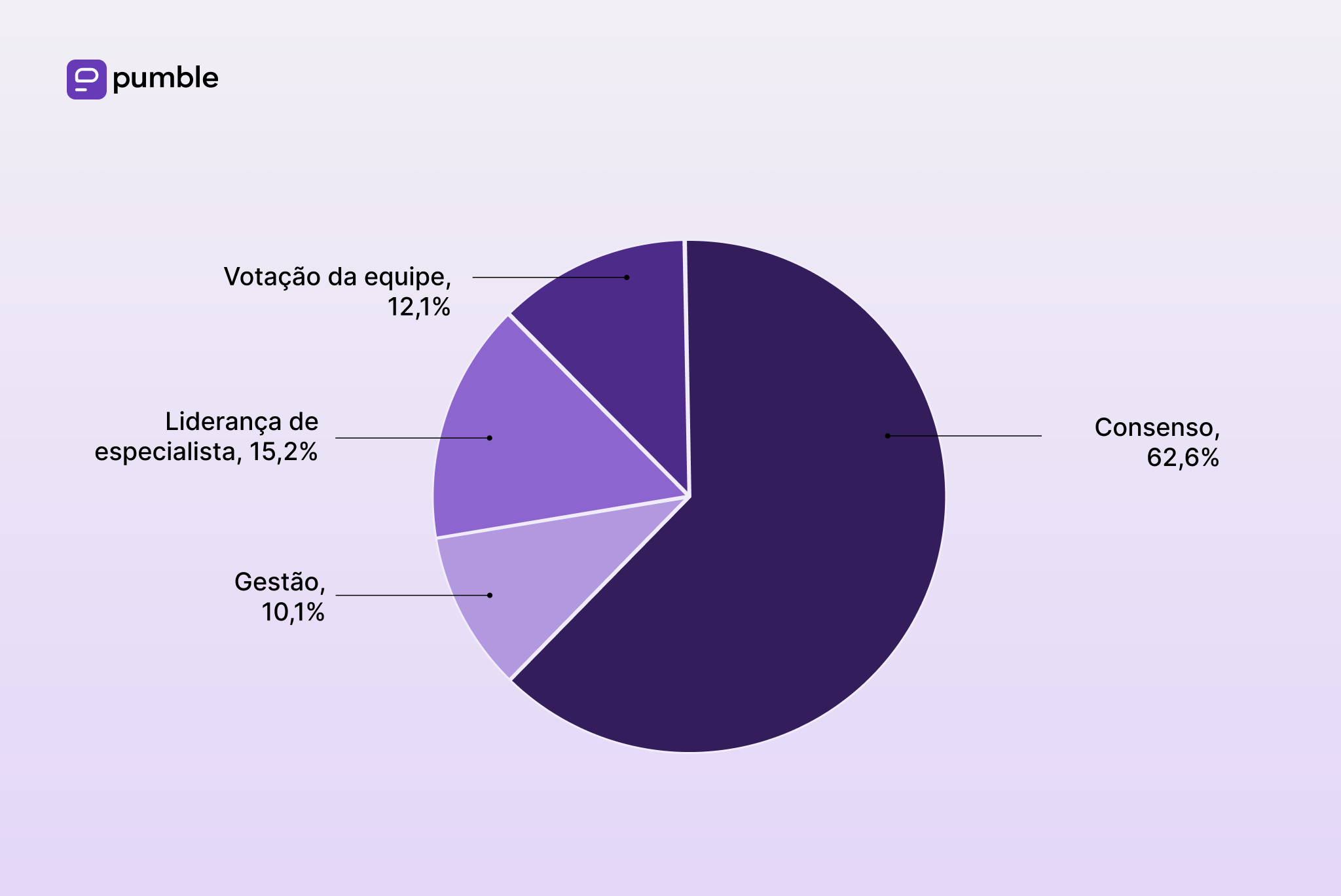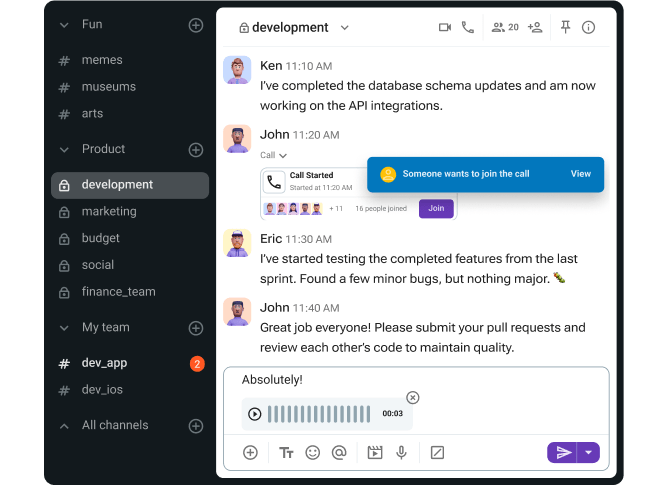Existem muitas maneiras de classificar os tipos de equipes. Em certo sentido, nenhuma classificação é completamente precisa, devido à grande complexidade do cenário de trabalho em grupo. Ainda assim, mesmo uma diferenciação aproximada pode ser útil para reconhecer e selecionar o tipo apropriado de equipe para uma organização.
Este artigo busca explorar os critérios pelos quais os tipos de equipe são identificados e detalhar alguns tipos notáveis de equipes. Além disso, exploramos as maneiras pelas quais as equipes listadas colaboram, juntamente com contextos na forma de exemplos.

Quais são os critérios para definir diferentes tipos de equipes?
Tipos de equipes são as diferentes maneiras de categorizar equipes usando diferentes parâmetros.
Podemos usar um grande número de critérios para categorizar tipos de equipes. Mas primeiro, como podemos definir o que é uma equipe? Em termos simples, uma equipe é um grupo de pessoas com funções definidas, trabalhando juntas em uma tarefa. Cada membro compartilha a responsabilidade pelos resultados que a equipe alcança. Além disso, os membros da equipe se veem como partes de uma entidade que também pertence à estrutura social da empresa. Como tal, as equipes existem em muitos cenários diferentes, e o trabalho em equipe é uma habilidade essencial para a maioria dos funcionários hoje.
Para começar, precisamos reconhecer que não há uma tipologia amplamente aceita de equipes. Colocar equipes em categorias separadas pode ser uma tarefa difícil, pois há muitos parâmetros que poderíamos usar para fazer isso. Alguns dos parâmetros comuns mais usados para diferenciar tipos de equipes incluem permanência do grupo, estrutura da equipe, estilo de liderança e tipo de colaboração.
Permanência do grupo
A existência de uma equipe pode ser de curto ou longo prazo. Isso depende de quanto tempo é necessário para atingir seu propósito definido. Em termos de permanência do grupo, reconhecemos equipes temporárias e equipes permanentes.
Equipes temporárias
As equipes temporárias estão principalmente preocupadas em terminar sua tarefa com prazo determinado. Uma vez que isso é alcançado, a equipe pode se separar. Os membros dessas equipes geralmente não têm tempo para conhecer os pontos fortes uns dos outros, ao contrário das equipes permanentes.
Exemplo de uma equipe temporária
Um time de contenção de crises respondendo a um vazamento de óleo. Esta equipe é composta por especialistas de várias áreas, colaborando para encontrar soluções ideais. A equipe se desfaz quando seu objetivo de gerenciar o vazamento de óleo é alcançado.
Equipes permanentes
Por outro lado, as equipes permanentes são compostas por pessoas que trabalham juntas ao longo do ano. Elas conhecem os pontos fortes umas das outras e podem atribuir tarefas para as pessoas mais adequadas lidarem com elas. A coesão social é importante para esse tipo de equipe, pois os sentimentos dos membros podem afetar todo o grupo.
Exemplo de uma equipe permanente
Uma equipe de operadores de armazém. Esta equipe consiste em funcionários em tempo integral, trabalhando em tarefas semelhantes durante todo o ano. Às vezes, eles saem para beber juntos, mostrando sua proximidade desenvolvida pelo trabalho em estreita proximidade.
Estrutura da equipe
A estrutura de uma equipe se refere às maneiras como os membros da equipe se relacionam entre si. Isso inclui as maneiras pelas quais as funções dos membros são interdependentes. Em um sentido mais amplo, é também como eles estão inseridos dentro do sistema maior da empresa.
Exemplo de estrutura de equipe
Equipes de guardas dentro de centros de detenção são um exemplo extremo da importância da estrutura da equipe. Se um membro da equipe comete um erro ao seguir o protocolo, isso pode causar consequências graves para outros membros da equipe. Talvez um guarda não perceba uma arma escondida, fazendo com que um colega se machuque.
Estilo de liderança
Os estilos de liderança podem variar ao longo do espectro de relaxados e democráticos a altamente autocráticos. Líderes democráticos permitem aos trabalhadores mais autonomia e contribuição criativa. Geralmente, os funcionários nesses tipos de locais de trabalho são mais felizes e, portanto, mais produtivos. Em contraste, um líder autoritário toma todas as decisões, com pouca ou nenhuma preocupação com o feedback dos funcionários. Isso torna o local de trabalho repleto de uma atmosfera de medo, removendo espaço para expressão criativa e inovação.
Exemplo de estilo de liderança
Os funcionários de uma agência de viagens vêm trabalhar todos os dias inseguros sobre sua estabilidade no emprego. Seu chefe é conhecido por ser caprichoso e tem tolerância zero para erros. Ele toma todas as decisões de marketing, que infelizmente são completamente ineficazes. Os funcionários têm muito medo de sugerir melhorias. Como consequência, há uma tendência constante de queda nos lucros da empresa. Isso causa um comportamento ainda mais errático do chefe, criando um ciclo vicioso para os funcionários estressados. Este é um exemplo de liderança autocrática.
Tipo de colaboração
Os tipos de colaboração de equipe referem-se aos métodos de coordenação e comunicação que uma equipe usa. Isso pode incluir diversas tecnologias, bem como horários e espaços nos quais uma equipe pode colaborar.
Exemplo de tipo de colaboração
Uma equipe de jornalistas esportivos colabora em tempo real, usando um espaço virtual. Eles compartilham informações pertinentes e rascunhos de seu trabalho. Eles fazem isso usando um aplicativo de chatq em equipe, permitindo-lhes uma forma de comunicação eficiente e simples.
🎓 Para saber mais sobre tipos específicos de colaboração confira nosso guia aprofundado sobre o tópico de tipos de colaboração.
Quais são os diferentes tipos de equipes, de acordo com sua estrutura e funções?
Ao se deparar com informações conflitantes, delinear tipos de equipes pode rapidamente se tornar confuso. Diferentes autores usam diferentes critérios. Na prática, isso torna o desenvolvimento de uma tipologia de equipe unificada muito complexo. Isso também causa sobreposição significativa entre os tipos mais conhecidos, bem como muitos termos que descrevem o mesmo fenômeno. Para simplificar, podemos nos referir a um método de categorização frequentemente citado. Essa classificação foi formulada para descrever tipos separados de grupos de trabalho. Ela sugere a existência de seis tipos distintos de equipes de trabalho: grupos de produção, equipes de serviço, equipes de gerenciamento, grupos de projeto, equipes de ação e desempenho e equipes de consulta.
Grupos de produção
As equipes de produção são unidades de trabalho permanentes que consistem em membros que produzem e lidam com produtos tangíveis. Isso significa que os membros da equipe geralmente são responsáveis por construir ou montar produtos, bem como manter e fazer a manutenção do equipamento. O fato destas equipes lidarem com tarefas mais práticas significa que as características físicas e psicomotoras dos membros da equipe são especialmente importantes.
Outra característica das equipes de produção é uma participação estável e em tempo integral. A participação é estável em algumas partes porque as tarefas de produção geralmente exigem treinamento extensivo. Os membros da equipe são treinados para realizar suas tarefas de forma eficiente e em sincronia com os outros.
As equipes de produção geralmente são dirigidas por supervisores, que tomam a maioria das decisões. Eles também podem formar um subtipo específico — equipes funcionais.
Equipes funcionais: um subtipo de equipes de produção
Equipes funcionais são o tipo tradicional de equipe. Provavelmente é nisso que a maioria das pessoas pensam quando imaginam uma equipe: um grupo de pessoas trabalhando no mesmo departamento, designadas com diferentes tarefas. As equipes funcionais possuem uma estrutura de equipe bem estabelecida, ajustada para executar tarefas pequenas, previsíveis e rotineiras. Além disso, elas têm um gerente designado encarregado de supervisionar o grupo.
As desvantagens dos grupos funcionais são mais visíveis quando uma mudança de ritmo é necessária. Devido à sua natureza rígida, a mudança é lenta e meticulosa. Como resultado, essas equipes também não são muito hábeis na comunicação entre as unidades.
Como os grupos de produção colaboram
Um requisito importante para os grupos de produção é a coordenação bem-sucedida dos esforços dos membros da equipe. Isso se deve à necessidade de trabalho sincronizado, pois as suas funções geralmente são interdependentes. Portanto, cada etapa é necessária para avançar em direção ao objetivo comum. Com os grupos de produção, a colaboração geralmente depende de interações pessoais, incluindo reuniões regulares para manter todos informados. Como os grupos de produção estão vinculados a espaços físicos, a comunicação também é realizada em tempo real.
Exemplo de grupos de produção
Jennifer é uma trabalhadora de linha de montagem em uma fábrica que produz produtos eletrônicos. Para concluir cada etapa da produção, ela precisa seguir protocolos atribuídos. Ela, assim como seus colegas, é responsável por tarefas específicas. Suas tarefas são rotineiras e se repetem em ciclos diários e semanais. Jennifer se comunica com seus colegas e seu chefe pessoalmente, durante o horário de trabalho.
Equipes de serviço
As equipes de serviço consistem em membros da equipe que realizam transações repetidas com os clientes. Essas equipes são semelhantes em estrutura e estilo de liderança às equipes de produção. A principal diferença entre os dois tipos de equipes é que, em vez de construir e manter produtos, as equipes de serviço interagem com fluxos de clientes.
Como consequência, o ambiente das equipes de serviço é mais imprevisível do que o das equipes de produção. Os membros da equipe precisam ter algum nível de habilidades interpessoais e de improvisação. Para auxiliar na comunicação com os clientes, os membros da equipe passam por treinamento apropriado. Eles precisam obedecer às diretrizes comportamentais fornecidas pela gerência. Essas diretrizes enumeram diferentes cenários que um funcionário pode encontrar, bem como maneiras de lidar com eles.
Geralmente, as equipes de serviço também têm figuras de supervisão. Essas pessoas lidam com a coordenação da equipe e resolvem problemas para os quais seus funcionários não estão treinados.
Como as equipes de serviço colaboram
As equipes de serviço colaboram principalmente no local de trabalho. A maior parte da comunicação é verbal e ocorre em tempo real. Algumas exceções podem ser avisos importantes ou regulamentos de conduta do cliente. Além disso, o horário de trabalho e os dias de licença com atestado médico podem ser discutidos por meio de mensagens de texto ou aplicativos de comunicação.
Exemplo de equipes de serviço
Nick é garçom em um restaurante popular. Suas responsabilidades incluem cumprimentar os clientes e anotar seus pedidos, depois comunicá-los à equipe da cozinha. Quando os pedidos são concluídos, Nick tem que entregar as refeições e as bebidas aos clientes, cobrar pelo serviço e se despedir deles quando se preparam para sair. Quando o trabalho está lento, ele também ajuda com as tarefas de limpeza.
Nick se comunica com seus colegas principalmente pessoalmente ou por mensagens de texto. Atualizações importantes de políticas são enviadas para seu e-mail. Em suas tarefas diárias, Nick colabora com outros membros da equipe, certificando-se de ser o mais claro possível sobre o que os clientes desejam. Ele executa suas tarefas com ardor, tentando minimizar o fardo para outros membros da equipe. Ele costuma contar piadas leves para tornar o ambiente de alta pressão menos tenso. Durante as reuniões, ele está aberto a compartilhar ideias sobre o que pode ser melhorado no processo de serviço.
Equipes de gerenciamento
Equipes de gestão são grupos de pessoas que administram uma organização. Os membros da equipe de gestão são responsáveis pela eficácia geral das unidades que se reportam diretamente a eles. Essas são as pessoas que planejam e formam estratégias para o futuro da empresa. Diferentes membros da equipe são responsáveis por diferentes funções dentro da empresa, com pessoas em níveis de gestão mais altos coordenando seus esforços. Com cada nível de gestão coordenando subunidades sob sua jurisdição, uma hierarquia piramidal se desenvolve. No topo da hierarquia de gestão está a equipe de gestão executiva, responsável pela tomada de decisões estratégicas de longo prazo.
Os membros da equipe criam uma visão do futuro da empresa. Então, eles se certificam de compartilhá-la efetivamente com os outros. Eles combinam seus esforços para tornar a visão realidade, estabelecendo uma estrutura organizacional sólida. Os gerentes precisam garantir que os funcionários cumpram certos padrões. Eles também precisam levar em consideração possíveis riscos e fazer o melhor para tentar mitigá-los. Eles fazem isso monitorando fatores externos e combatendo-os com meios apropriados.
Como as equipes de gerenciamento colaboram
O principal modo de colaboração e comunicação entre os membros da equipe de gestão geralmente são reuniões presenciais. Elas ocorrem semanalmente, mensalmente e trimestralmente.
- Reuniões semanais podem lidar com atualizações de status e desenvolvimento ou discussão de ideias.
- Reuniões mensais fazem isso em uma escala maior, focando em atualizações significativas de políticas, resultados de desempenho ou grandes mudanças estratégicas.
- Reuniões trimestrais geralmente duram entre 2 e 4 horas e realizam uma análise aprofundada do desempenho, focando em uma função ou área geográfica específica.
Outras comunicações diárias ou atualizações menos importantes podem ser feitas por meio de ferramentas de colaboração online ou e-mail.
Exemplo de equipes de gerenciamento
Já faz alguns meses que uma empresa de desenvolvimento de software lançou um novo aplicativo. Após uma atualização recente, muitos clientes estão reclamando que o aplicativo é difícil de usar. Portanto, o tópico principal da reunião semanal de gerenciamento é discutir maneiras de melhorar a experiência do usuário. Após uma longa discussão, a equipe de gerenciamento decide designar um desenvolvedor experiente para resolver o problema. As responsabilidades habituais do desenvolvedor são colocadas em espera, devido à urgência da situação.
Grupos de projeto
Equipes de projeto são grupos que executam tarefas especializadas dentro de um prazo definido. Essas equipes produzem entregáveis, como novos produtos ou serviços. O desenvolvimento de novos produtos consiste em tarefas não repetitivas e trabalho original. Assim, os membros da equipe precisam ser conhecedores, com julgamento claro e experiência.
O projeto começa depois que a gerência sênior define o objetivo. Em seguida, eles atribuem funções aos membros da equipe, com base em sua expertise. Isso significa que a participação geralmente não é voluntária. As equipes de projeto com mais frequência fazem o seguinte:
- Resolvem problemas de qualidade de produtos — 57% do tempo
- Elaboram estratégias de negócios — 47% do tempo
- Desenvolvem novos produtos, clientes ou mercados — 40% do tempo
As equipes de projeto são mais flexíveis e tendem a ter menos dependências técnicas, mecânicas e de espaço de trabalho. Elas não são tão vinculadas à organização e podem executar uma ampla gama de tarefas intelectuais.
Em relação à duração, podemos diferenciar entre:
- Equipes de projeto ad hoc. Equipes ad hoc de curto prazo são formadas para um ciclo de tarefas. Isso significa que elas existem para um propósito único e muito específico.
- Equipes de projeto em andamento. Equipes de projeto de longo prazo recebem novas tarefas ou executam ciclicamente as mesmas tarefas. A satisfação e a motivação dos membros são mais importantes para esse tipo de equipe, pois as pessoas colaboram por períodos mais longos.
As equipes de projeto são temporárias por natureza e geralmente se dissolvem após o término do projeto. Após a dissolução da equipe, os membros retornam às suas unidades originais ou ao próximo projeto.
Na maioria dos casos (até 78%), as equipes de projeto tendem a ser multifuncionais. Isso significa que os membros da equipe são escolhidos de diferentes disciplinas e unidades funcionais. Eles precisam possuir as habilidades apropriadas necessárias para lidar com o projeto. Essas equipes também podem ser equipes matriciais, sob circunstâncias específicas.
Equipes multifuncionais: um subtipo de grupos de projeto
Essas equipes podem ser listadas como uma variedade mais permanente de equipes de projeto. Equipes multifuncionais consistem em membros de diferentes departamentos, trabalhando juntos em um objetivo comum definido.
O principal benefício de uma equipe multifuncional é seu nível de produtividade. Especialistas de vários campos unificados por uma causa comum produzem resultados com muita rapidez. Por virem de origens diversas, esses especialistas podem colaborar em uma ampla gama de projetos. Junto com o aumento do alcance, reunir diferentes perspectivas pode levar à abertura de espaços para inovação.
Por outro lado, equipes multifuncionais têm seu próprio conjunto de desafios. Ou seja, que muitas vezes são muito disfuncionais. Essa disfunção é mais aparente quando se trata de questões de colaboração entre os membros da equipe. Primeiro, os membros vêm de unidades diferentes, o que torna a comunicação lenta, a menos que a empresa ofereça uma plataforma de colaboração unificada. O outro grande motivo é que os especialistas tendem a ser mais apegados à sua opinião pessoal, o que os torna mais propensos a entrar em conflito uns com os outros.
Equipes matriciais: um subtipo de grupos de projeto
Em termos simples, uma equipe matricial é um sistema de dois chefes. Um deles é o gerente supervisor de todo o projeto e o outro é o líder especialista com quem um funcionário se comunica diretamente.
As equipes matriciais são benéficas devido à flexibilidade dos funcionários, possivelmente porque a gerência não atrapalha as atividades diárias. Em vez disso, os trabalhadores são supervisionados principalmente por um líder experiente. Essa pessoa tem muito conhecimento sobre os requisitos do processo do projeto e tem expectativas realistas de seus funcionários.
Uma grande desvantagem das equipes matriciais é a necessidade de relatórios duplos pelos funcionários. Esses relatórios consomem tempo e energia valiosas. Além disso, os trabalhadores geralmente ficam confusos e frustrados quando seus supervisores lhes dão instruções conflitantes.
Como os grupos de projeto colaboram
As equipes de projeto colaboram combinando os esforços individuais de todos os membros da equipe. Como a maioria dos membros da equipe vem de diferentes departamentos ou unidades funcionais, todos eles têm perspectivas únicas a oferecer. O compartilhamento e a discussão de ideias acontecem em reuniões organizadas regularmente. Essas reuniões podem ocorrer no escritório ou online por meio de ferramentas de conferência de áudio e vídeo. À medida que o processo do projeto muda em ritmo acelerado, os membros da equipe acham as ferramentas de comunicação síncrona mais eficientes do que a correspondência tradicional por e-mail. Portanto, uma solução técnica sólida é essencial quando se trata de compartilhar informações e conversas instantâneas.
O tipo de gestão mais adequada para equipes de projeto é aquela que permite que os funcionários atuem de forma autônoma ou semi autônoma. Isso permite que os funcionários, que geralmente são especialistas em sua área, expressem todo o seu potencial. Uma maneira de aumentar o senso de autonomia é envolver os trabalhadores nohe processo de tomada de decisão.
Dentro das equipes de projeto, a tomada de decisão é feita usando estas técnicas:
- Consenso — 62% das vezes
- Líder ou especialista decide — 15% dos casos
- Voto da equipe — 12% das vezes
- Gestão — em 10% dos casos
Essas estatísticas sugerem que muito valor é dado à contribuição dos funcionários. Em particular, parece que uma abordagem democrática e colaborativa para a tomada de decisões mostra os melhores resultados. Uma razão para isso pode ser o fato de que as pessoas que têm permissão para trabalhar de forma autônoma também sentem um maior senso de responsabilidade pelo resultado do projeto. Isso as leva a ter um melhor desempenho, pois têm uma sensação de recompensa quando uma tarefa é concluída com sucesso.

Exemplo de grupos de projeto
A alta gerência de uma vinícola de luxo reúne uma equipe encarregada de lançar um novo produto. Cleo é um designer gráfico dessa equipe, cujo trabalho é produzir material promocional, bem como o protótipo do site. Para criar uma boa representação visual do novo produto, Cleo precisa da contribuição de diferentes membros de sua equipe.
Primeiro, ele precisa perguntar a Ray do marketing sobre a impressão geral que ele deve projetar. Eles trocam mensagens por meio de um aplicativo de comunicação em equipe, e ele recebe suas instruções básicas.
Em seguida, ele precisa manter contato regular com a equipe de desenvolvimento web, para verificar se suas ideias para o site fazem sentido técnico.
Cleo pode até decidir entrar em contato com o sommelier, para ter uma ideia melhor do novo vinho. Isso só pode ser feito pessoalmente, pois o degustador acredita que a tecnologia afeta sua sensibilidade gustativa. Cleo decide ir além, pois as descrições e associações que ele fornece inspiram ideias originais.
Ao juntar essas informações, a Cleo consegue produzir um design original e de maior qualidade.
Grupos de ação e desempenho
Grupos de ação e performance realizam tarefas e performances complexas e limitadas no tempo que envolvem ambientes públicos, adversários ou hostis. Os membros da equipe geralmente são especialistas altamente treinados e experientes. Juntos, eles desempenham papéis complementares e interligados. Alguns exemplos incluem equipes de negociação, bombeiros, equipes de cirurgia, unidades investigativas, unidades de busca e resgate, músicos profissionais, etc.
Como os grupos de ação e desempenho colaboram
As pessoas nessas equipes têm conhecimento especializado de padrões e protocolos de performance. Na prática, isso significa que os membros da equipe podem desempenhar suas funções sem treinamento prévio ou introdução a outros membros da equipe e suas funções. Um cirurgião pode realizar uma cirurgia mesmo que nunca tenha conhecido seu anestesista antes. Em certo sentido, isso ocorre porque todos os cirurgiões e todos os anestesistas (se forem especialistas) realizariam a mesma tarefa na mesma situação. Portanto, a colaboração entre os membros da equipe desse tipo de equipe depende do ambiente e dos protocolos atribuídos.
Exemplo de grupo de ação e desempenho
Becca é uma vocalista treinada. Ela tem a oportunidade de fornecer vocais de apoio para o novo single de um artista popular. Ela chega ao estúdio, onde recebe a partitura e as amostras de som do que ela deve almejar. Becca se encaixa rapidamente, e o trabalho é feito em pouco tempo. Isso ocorre porque ela e a equipe do estúdio são profissionais, que precisam de orientação mínima para poderem cooperar.
Equipes consultivas
Grupos consultivos também são chamados de equipes paralelas ou equipes para aconselhamento e envolvimento. Essas equipes reúnem pessoas de diferentes unidades de trabalho para executar tarefas que a organização não está equipada para fazer. Elas são chamadas de equipes paralelas porque funcionam em paralelo com o processo de produção. Os gerentes formam temporariamente círculos de qualidade, painéis de seleção e outros grupos consultivos para resolver problemas e recomendar soluções.
Como as equipes consultivas colaboram
A maneira como um grupo consultivo pode colaborar depende da tarefa que lhes foi atribuída. As tarefas diárias podem ser coordenadas por meio de reuniões presenciais ou correspondência online. Outras atualizações mais importantes podem ser comunicadas por escrito, seja por e-mail ou cópias físicas.
Exemplo de equipes consultivas
A equipe de RH de uma empresa de marketing, Stephanie e Anna, precisa realizar uma pesquisa de satisfação dos funcionários regularmente programada. Elas têm que analisar cuidadosamente a lista de perguntas que desejam fazer durante uma reunião informal, compartilhando sugestões e modificando a pesquisa. Elas imprimem o questionário e cada um concorda em distribuir a pesquisa para os departamentos selecionados. Após receberem as respostas, elas se reúnem novamente para revisar os resultados e escrever um relatório para a gerência.
Uma abordagem alternativa — o continuum da equipe
Há uma pesquisa que propõe uma solução alternativa para categorias estritas de equipes. Essa solução vem no conceito de um continuum de equipe. Isto é visualmente representado por uma linha direcional, significando a mudança de qualidades na direção indicada.
No lado esquerdo do continuum da equipe estão grupos que tendem a:
- Ser mais reativos. Equipes reativas precisam avaliar rapidamente situações, priorizar tarefas e responder rapidamente de forma apropriada. Essas equipes frequentemente usam protocolos para aumentar a eficiência.
- Lidar com problemas intra-equipe. Essas equipes se concentram em questões internas da equipe enquanto colocam mais ênfase no trabalho colaborativo do que individual.
- Produzir resultados incrementais. Elas geralmente têm prazos fixos para a entrega de produtos.
Progredindo para a direita, as equipes adquirem características que:
- As tornam cada vez mais proativas. Equipes proativas geralmente operam produzindo uma estratégia e, então, implementando-a sistematicamente.
- Abordam questões mais amplas. Essas equipes olham além do escopo delas mesmas. Elas podem lidar com uma gama maior de problemas.
- Focam na autonomia dos funcionários. Essas equipes valorizam e nutrem a independência dos trabalhadores. Elas estão focadas em produzir funcionários completos.
Aqui, podemos olhar para uma representação visual do continuum da equipe. Há algumas marcas ao longo dessa linha conceitual, denotando alguns tipos comuns de equipes. Essas marcas não pretendem de forma alguma representar os únicos tipos de equipes, elas são apenas pontos ao longo desse espectro.

Exemplo de um tipo de equipe no continuum da equipe
Uma força-tarefa é um tipo de equipe formada para um propósito especial. Essas equipes trabalham em projetos específicos e contêm várias unidades ou organizações. As forças-tarefa são empregadas para encontrar soluções para problemas críticos. No continuum de equipe, elas estão localizadas no centro-esquerda, marcando-as um pouco, mas não completamente reativas. Além disso, elas podem ser descritas como mais focadas em um objetivo singular.
Classificações adicionais de equipes
Existem outras maneiras de distinguir entre equipes, além dos limites das categorias anteriores. Todos os diferentes tipos de equipes que descrevemos também podem se encaixar em algumas dessas categorias.
Tipos de equipes com base no tipo de gerenciamento
Cada equipe precisa ter um planejamento estratégico, tomada de decisão e coordenação adequada dos membros da equipe . Tomar decisões sobre movimentos futuros e manter a coesão social da equipe sob controle pode ser uma tarefa exigente. Essas tarefas podem ser uma responsabilidade compartilhada dos membros da equipe ou o dever de uma figura de supervisão selecionada ou designada. Com vários níveis de autonomia em mente, podemos categorizar as equipes naquelas com estes tipos de gerenciamento: equipes lideradas por supervisores, equipes semi autônomas e equipes auto gerenciadas.
Equipes lideradas por supervisores
Equipes desse tipo têm uma figura supervisora eleita ou nomeada. Essa pessoa pode, às vezes, levar em consideração a contribuição dos funcionários sob sua supervisão, mas geralmente toma a maioria das decisões por conta própria. Essa forma de gerenciamento é mais comum em equipes de produção e serviço, pois suas tarefas são tradicionalmente vistas como mais simples. Com a crescente complexidade das tarefas, os membros da equipe têm mais probabilidade de exercer influência pessoal e tomar decisões autônomas.
Em equipes estritamente lideradas por supervisores, a maior parte do sucesso da unidade depende da competência do líder. O líder precisa ser capaz de prever corretamente as etapas futuras necessárias, bem como coordenar e extrair todo o potencial de seus funcionários.
Equipes semiautônomas
Equipes semiautônomas têm supervisores de alto escalão designados. No entanto, elas também recebem informações de outros membros da equipe. Isso pode ser feito por meio de canais de comunicação formais ou durante conversas informais.
Equipes autogerenciadas
Equipes auto gerenciadas se referem a equipes nas quais os funcionários tomam as decisões. Essas equipes não têm autoridade gerencial. Eles são formados por colegas treinados em diversas habilidades, todos trabalhando de forma independente para atingir um objetivo comum.
O senso adicional de responsabilidade compartilhada que vem junto com a autonomia faz com que as pessoas se importem mais com o sucesso da equipe.
Em uma nota menos positiva, não ter uma figura de autoridade pode levar à conformidade. Isso acontece porque as pessoas tentam não entrar em conflito com os outros, pois sentem a necessidade de serem aceitas. Quando deixadas por conta própria, as pessoas mais naturalmente assertivas assumem a liderança informal, enquanto as outras tentam não perturbar o status quo.
Exemplo de equipes com vários tipos de gerenciamento
- Jerry é o gerente de um armazém de componentes elétricos para atacado. Os trabalhadores dentro de sua unidade têm reclamado de excesso de trabalho. O negócio passou por um grande crescimento recentemente, e não houve novas contratações para dar suporte à nova carga. Jerry é da opinião de que os trabalhadores são simplesmente mimados e que eles podem administrar suas tarefas muito bem. Depois de algum tempo, alguns trabalhadores pedem demissão e a revisão anual mostra um sério manuseio incorreto de faturas. Como resultado, tanto o ego de Jerry quanto seu salário são afetados. Este é um exemplo de uma equipe liderada por um supervisor, onde o supervisor é autocrático.
- Ewan trabalha em uma oficina de carpintaria. Ele e seus colegas organizaram seu trabalho de uma forma que lhes permite total autonomia na tomada de decisões. Ewan fala com os clientes, então organiza suas tarefas e define sua própria agenda. Ele determina pessoalmente o preço dos serviços, mas delega a contabilidade a outro colega. Este é um exemplo de uma equipe autogerenciada que funciona bem.
Tipos de equipes com base no local de trabalho
Durante a maior parte da história humana, até as últimas décadas, fazer negócios com alguém significava fazê-lo pessoalmente. Com o progresso da comunicação e da tecnologia de viagens, o trabalho virtual se tornou possível. A invenção revolucionária da Internet tornou possível que o trabalho fosse feito por pessoas de todo o mundo. Mais recentemente, e infelizmente de forma mais urgente, a pandemia da COVID-19 tornou o escritório um lugar arriscado para se estar. Isso continua a influenciar cada vez mais equipes a mudar para um estilo de trabalho remoto.
Em relação ao local de trabalho, podemos categorizar as equipes em dois tipos:
Equipes co localizadas
Equipes co-localizadas são equipes cujos membros estão localizados no mesmo espaço físico. Eles têm a oportunidade de praticar colaboração presencial. Os membros da equipe co-localizada viajam para os escritórios, passam suas horas de trabalho no escritório ou no campo e voltam para casa depois. Durante suas atividades diárias, eles podem se comunicar com seus colegas simplesmente caminhando até eles e iniciando uma conversa.
Grupos co-localizados têm interações de melhor qualidade, devido a comunicação constante que consiste em sinais não verbais. Você reconhece instintivamente esses sinais por estar no mesmo espaço físico que a outra pessoa e por observar consciente e inconscientemente sua linguagem corporal. Essa capacidade permite a transferência mais fácil de informações e deixa menos espaço para falhas de comunicação.
Para a empresa, o trabalho co-localizado é mais caro do que o trabalho virtual. A empresa precisa alugar ou construir escritórios, que exigem manutenção constante. Para os funcionários, o deslocamento diário para cidades lotadas pode ser uma grande perda de tempo.
Equipes virtuais
Como todos os outros tipos de equipes, as equipes virtuais aplicam suas habilidades distintas para atingir um objetivo organizacional comum. A única diferença é que essas equipes usam a tecnologia para preencher a lacuna entre as localizações geográficas dos membros da equipe e as restrições de tempo. O tipo de tecnologia que eles usam se enquadra em duas categorias distintas:
- Síncrono. A tecnologia síncrona oferece suporte a interações em tempo real. Alguns exemplos são ferramentas de conferência de áudio e vídeo ou um aplicativo de bate-papo em equipe.
- Assíncrono. Esse tipo de tecnologia é usado para interações que ocorrem em momentos diferentes. Alguns exemplos de tecnologia assíncrona incluem e-mail e quadros de avisos on-line.
Precisa de um aplicativo de comunicação? Experimente o Pumble
Como as equipes virtuais podem estar ativas durante todo o ciclo de 24 horas, elas podem ser mais produtivas do que as equipes co-localizadas. Além disso, elas têm acesso a diversos conjuntos de habilidades, experiências e conhecimento sobre clientes e negócios.
Em seguida, não há necessidade de escritórios, o que significa que o dinheiro pode ser economizado em aluguel, construção e manutenção de espaços da empresa, e não haverá tempo desperdiçado em deslocamentos. Isso melhora significativamente o equilíbrio entre vida pessoal e profissional dos funcionários. Além disso, as equipes virtuais são comumente compostas por pessoas com diversas origens culturais. Essa diversidade abre espaço para mais inovação e promove a igualdade.
Uma desvantagem das equipes virtuais é a falta de sinais não verbais presentes nas interações presenciais. Conforme explicado no segmento sobre equipes presenciais, esses sinais não verbais constituem a maior parte da comunicação interpessoal. Infelizmente, eles são muito menos aparentes, por exemplo, em videoconferências, às vezes tornando a comunicação estranha e atrofiada.
Exemplo de equipe presencial x virtual
- Equipe presencial. Carolina tem sua própria marca de roupas. Ela faz todo o design e costura sozinha, mas contrata Claire e Marc para ajudá-la com o marketing e envio de pedidos. Carolina pode ser perfeccionista quando se trata da imagem de sua marca e tem que comunicar muito claramente o que ela espera deles. Eles fazem isso tendo longas conversas durante o café, ajudados com desenhos improvisados e gestos descritivos. Cara mostra a Marc na prática exatamente como ela quer que seus pedidos sejam embalados, fornecendo também um guia visual na forma de fotos tiradas de tipos específicos de pedidos. A colaboração presencial é o tipo de comunicação mais viável para Cara e sua equipe. Isso se deve à sua demanda por atenção aos detalhes e à necessidade de manuseio físico dos produtos.
- Equipe virtual. Kris tem uma ideia para o que ela acredita que seria um aplicativo revolucionário. No entanto, ela não consegue construí-lo sozinha e decide organizar uma equipe. Ela recorre a recursos online e descobre que os moradores indianos Satvik e Sai, assim como Pyotr da Rússia, estão dispostos a participar por uma compensação justa. As fases iniciais do desenvolvimento são repletas de mal-entendidos frustrantes sobre a incapacidade de se entenderem durante as videochamadas. Quando a equipe finalmente concorda em começar a usar um aplicativo de bate-papo em equipe, sua comunicação melhora drasticamente. Isso acontece porque o aplicativo permite que a equipe se comunique em tempo real enquanto permanece focada na comunicação escrita. Isso permite que os membros da equipe sejam claros sobre suas intenções, sem sotaques fortes e ecos irritantes atrapalhando.
Tipos de equipes com base em uma distinção cultural
Existem outros efeitos do aumento da frequência de equipes trabalhando remotamente. Como os membros da equipe estão geograficamente dispersos por todo o planeta, eles também vêm de origens culturais. significativamente diferentes. A origem cultural de uma pessoa, na maior parte, molda suas opiniões, atitudes, preconceitos e comportamento. Quando essas características variam amplamente entre os membros da equipe, isso pode afetar significativamente a comunicação, a colaboração e a dinâmica da equipe. Alguns dos desafios das equipes multiculturais podem ser:
- Barreira linguística. Apesar do inglês ser a língua não oficial, mas amplamente reconhecida, dos negócios internacionais, os membros da equipe podem ser proficientes nele em diferentes níveis. Este também é um problema com outros idiomas que uma equipe pode enfrentar. Diferentes níveis de proficiência no idioma podem causar mal-entendidos frequentes e perda de tempo tentando explicar conceitos.
- Diferentes perspectivas sobre o trabalho. Diferentes culturas têm ideias muito variadas sobre que tipo de papel o trabalho tem na vida de uma pessoa. Horas extras não remuneradas podem ser consideradas completamente normais e esperadas, enquanto em outros lugares constituem uma intrusão severa na vida privada de uma pessoa.
- Diferentes ideias sobre liderança. Culturas ao redor do mundo têm, em alguns casos, opiniões muito fortes sobre a questão de quem é competente e apropriado para se tornar um líder. Por exemplo, em algumas áreas do mundo, ainda é incomum ter mulheres em posições de liderança. A tensão pode surgir quando um membro da equipe com a crença de que uma mulher não deve ser uma líder entra em contato com uma chefe do sexo feminino. Resistência e sabotagem estão quase fadadas a acontecer. Essas crenças podem ser rastreadas, mas muitas vezes podem passar despercebidas, devido à maioria dos ocidentais raramente considerar esse tipo de situação.
- Atitudes diferentes em relação à colaboração. Semelhante à questão da liderança, a colaboração também pode ser dificultada por origens culturais amplamente diferentes. Podemos nos referir novamente à questão de gênero, pois às vezes até mesmo a religião de alguém pode proibi-lo de trabalhar junto com uma pessoa do sexo oposto.
Para explorar mais as diferenças com base em origens culturais, podemos apresentar uma distinção simples entre esses tipos de equipes:
Equipes de cultura única
Essas equipes consistem exclusivamente de pessoas que se percebem como parte de uma única cultura. Como tal, elas são principalmente uniformes quando se trata de expectativas no local de trabalho em termos de comportamento e atitudes apropriadas. Como a barreira do idioma é inexistente, os membros da equipe se comunicam com pouca preocupação de serem gravemente incompreendidos. Essas características podem tornar o local de trabalho mais relaxado e amigável.
Por outro lado, pouca diferença pode ser um catalisador para a conformidade. As pessoas ficam confortáveis e aconchegadas e tendem a fluir com o humor, as ideias e as opiniões predominantes da multidão. Opiniões diferentes e até mesmo conflitantes são frequentemente o berço de ideias originais. Quando todas as pessoas na equipe cresceram e viveram em circunstâncias semelhantes, é menos provável que encontrem soluções drasticamente divergentes para tarefas e problemas cotidianos.
Equipes multiculturais
Equipes multiculturais consistem em membros de diferentes esferas geográficas e culturais. Graças à tecnologia moderna, pessoas ao redor do mundo podem se reunir e trabalhar com um propósito comum. Esses avanços podem tornar os locais de trabalho mais complexos e difíceis de navegar, mas também podem tornar as equipes e seu trabalho mais inovadores e gratificantes.
Devido aos desafios listados acima, a comunicação em equipes multiculturais pode se tornar estranha e atrofiada. Quando pessoas com diferentes pressupostos se reúnem, é provável que haja choques de opinião e temperamento. Esses desafios podem ser superados com um processo cuidadoso de seleção de candidatos, juntamente com mediação constante em esforços de colaboração entre os membros da equipe. Quando esses desafios são superados, você pode experimentar um ambiente de trabalho mais emocionante, repleto de diversidade de culturas, opiniões e ideias.
Exemplo de equipes de cultura única vs. multiculturais
- Equipe monocultural. Uma equipe de agentes imobiliários trabalhando localmente. Gary e Sarah são membros desta equipe, trabalhando principalmente de forma independente, mas se reportando ao mesmo chefe — Gayle. Sarah e Gary se consideram iguais e não contestam a autoridade de Gayle com base em seu gênero. Esta questão nunca é questionada, não importa suas brigas e diferenças de opinião. Ao conversar, Gary e Sarah entendem o que o outro quer dizer e, se não entenderem, podem facilmente se explicar em termos simples.
- Equipe multicultural. Um comitê internacional supervisiona uma fábrica que está sendo construída. Este comitê é composto por especialistas vindos de vários campos e dois países. Uma parte da equipe vem de um país asiático que está investindo fundos para construir um posto avançado corporativo, enquanto a outra parte é do país europeu local onde a construção está ocorrendo. A barreira do idioma e as diferentes expectativas rapidamente se tornam pontos de conflito. Em algum momento, a falta de comunicação diária se torna tão obstrutiva que a gerência decide contratar um mediador cultural. Essa pessoa ajuda a diminuir a diferença cultural, explicando a ambos os lados suas diferenças de perspectiva e costumes.
Melhore a dinâmica da equipe com o Pumble
Seja você formando, mantendo ou participando de estratégias de colaboração de equipe, as informações deste artigo podem servir como uma bússola. Você pode usá-lo para ajudar a entender a dinâmica da equipe e seu papel dentro da equipe.
No entanto, para realmente elevar o potencial colaborativo da sua equipe, considere integrar o Pumble, um software de colaboração de equipe, ao seu kit de ferramentas.
Com suas mensagens diretas, compartilhamento de arquivos, vídeo e chamadas de voz, o Pumble faz maravilhas para todos os tipos de equipes, não importando suas diferenças.
Ao adotar o Pumble, você não está apenas investindo em uma ferramenta de comunicação; você está investindo em:
- Fluxos de trabalho simplificados,
- Transparência aprimorada e
- Conexões fortalecidas entre os membros da equipe.
Com o Pumble, você navegará pelas complexidades do trabalho em equipe com facilidade, impulsionando a produtividade e promovendo uma colaboração eficaz.
Adote o Pumble e desbloqueie todo o potencial do sucesso colaborativo.
Como avaliamos esta publicação: Nossos escritores e editores monitoram as postagens e as atualizam quando novas informações ficam disponíveis, para mantê-las atualizadas e relevantes.





